With the growth in technical sector, everything is growing rapidly and improving all the areas, and for this reason courier service also not too behind. It has improved in so many areas and become completely new by using so many upgraded technologies. In this content we will discuss this evolution of courier industry in decade by decade formation.
Humans often tend to see the future while thinking about logistics. It seems that shipping would become simpler, quicker, and safer as a result of the growth of AI and the complete automation of distribution networks. Take a moment to reflect, however, and think about how logistics have evolved. Since logistics has a long history, it only makes sense to think about how it has impacted global events and speculate on how things may have turned out differently if they had more sophisticated logistical systems.
Let us use this essay to examine the development of logistics over the last few decades and learn to appreciate what today people have more like international courier services.
Development of Logistics Over the Last Few Decades
Let us start with the late 1950s
After World War II, there was less of a need for logistical development. Thankfully, a shortage of demand did not lead to a lack of innovation. But for how much time it will be like that? Shipping businesses came back to commerce as they shifted their focus away from defence uses. One of the most important turning points in logistics history was the development of shipping crates in 1950. We mostly depend primarily on shipping crates in today’s logistics world. In such a way that thinking about logistics without relying on them would be difficult. Shipping containers were invented, which is significant even though it would be some time before humanity standardised them.
Let us talk about the 1960s
The number of trucks on the road increased significantly in the 1960s. The standardisation of materials as well as the safety improvement rendered logistics simpler and more predictable. This made it much easier for shipping firms to dump off products that needed to be delivered on time and convey time sensitive goods.
However, it was IBM’s advances in digital technology that had a real impact on contemporary logistics. Previously, all logistical information was communicated and written down on paper. However, IBM automated data in logistics. As you may guess, this made a major impact since it provided a view into the logistics industry’s future, and from here the growth of courier industry is increased rapidly.
Now start talking about the 1970s
The first warehousing real time control system appeared in nineteen seventy five. Managers of logistics might use it to track orders, keep an eye on inventories, and control distribution. Again, this represents a modern convenience that was once a significant development but nowadays people take it for granted. Barcodes were another invention of the 1970s that greatly facilitated packet identification. After that the courier process will change a little bit, because of new invention and upgradations.
It’s the time to talk about the 1980s
When it comes to logistics, the early 1980s were indeed a pivotal decade. There were not any “new items” worth mentioning, but what was previously there was much improved. The use of computers, tracking tools, logistics integration, modes of communication, and shipping tools. All these became progressively and more improved in this decades.
In the early 1990s
Until now, third party firms have often taken care of logistics. However, as technology developed, integrating logistics into your business got a lot simpler. When experts inquired, the moving team said that, much like most relocation companies, take care of their logistical requirements.
In the modern 2000s
Without a doubt, contemporary logistics refers to the history of logistics from the year 2000 towards the present. Early in the twenty first century, every one of the systems that exist now was developed. These systems were undoubtedly far more primitive when they were created than they are now. Nevertheless, they had their conception at this time.
There is no way to predict what the development of logistics will look like following the development of machine learning and artificial intelligence. You can immediately see how far humans have gone since the 1950s despite this brief overview of the history of logistics over the last few years. It is realistic to expect that the upcoming 100 years will hold some surprises. Within the 1950s, the notion of using computers in logistics was considered science fiction. Today, space shipping, completely automated ships, and interplanetary travel all seem like science fiction.
From the year 2010 till now
In the last two decades, there has been a change in shipping patterns, with emerging nations no longer exporting the majority of their goods. According to UNCTAD, developing country trade had an equilibrium that was more than three times packed to empty in 1970 but has changed to a more mutually beneficial trade through 2016. This pattern is most likely to persist.
Additionally, humans will also see an increase in the routes used to bring food and other raw materials into China via South America and Africa. Marine transportation is probably going to be moderated by the Great Silk Road, which will link Europe and China overland. Instead of lowering the actual amount of maritime cargo, this is more likely to take the form of slowing the pace of rise.
It’s a long way, shipping industry have covered to become this standard
As more innovations enter the marketplace to meet rising demand, the market for industrial maritime transport will only continue to expand. Improvements throughout marine & port infrastructure decreased personnel numbers on ships, and possibly even autonomous ships within the not too away future are all predicted by current developments, which also lead to better efficiency and much less environmental effect. International courier services have come a long way ahead.








